Dynamic Models with Sigmoid Corrections to Generation of an Achievable 4D-Trajectory for a UAV and Estimating Wind Disturbances
Abstract
1. Introduction
- A simple method of composing a primary piecewise continuous 4D trajectory in the form of a polyline, which defines in first approximation the path of the UAV passing through the given reference waypoints . We can use the fourth coordinate to set the average desired velocity of flight in different parts of the trajectory, not exceeding the maximum velocity of a particular vehicle. The novelty of the proposed approach consists in formalizing the requirements for a primitive trajectory. It is easy to ensure that they are satisfied at the design stage, but there is no opportunity for online correction;
- A ninth-order tracking differentiator with sigmoidal corrective actions to smooth the reference trajectory and generate allowable reference actions for UAV position, velocity, and acceleration component by component. We developed a decomposition procedure to set up its gains considering the design constraints on UAV state variables. It is also shown that unlike the sixth-order dynamic generator [16,17], in this case, we can additionally ensure that the constraints on the third and fourth derivatives are satisfied, obtain a smoother signal for the second derivative, and reduce the algorithm’s counting time. The novelty of the proposed approach lies in the fact that the tracking differentiator generates smooth signals and their derivatives of the required order (which is quite sufficient for the design of standard tracking systems) with automatic implementation of design constraints. The above traditional methods provide an analytical description of the reference actions but do not have full-fledged mechanisms to provide design constraints and require additional control;
- A combined control law that ensures that the UAV’s center of mass tracks a smoothed trajectory and is invariant to external uncontrollable disturbances by compensating them. A minimum-dimensional dynamic observer with sigmoidal corrective actions has also been developed, which estimates external disturbances by their effect on the control plant. Unlike known disturbance observers, the designed approach does not require a dynamic model of external disturbances and can estimate non-smooth disturbances with any given accuracy. The novelty of the proposed approach lies in the fact that in the design process, both the observation errors and their derivatives are stabilized. This makes it possible not to increase the dynamic order of the observer and to use its correcting actions instead of the observer’s variables for disturbance recovery.
2. Problem Definition
- The given path is in the working space, and the initial values of the reference actions and the controlled variables are sufficiently close:
- The curvature of the path is continuous and the given actions are quite smooth
- The values of the derivatives of the given actions do not exceed the design velocity and acceleration limits of UAV (5):
3. Theoretical Results
3.1. Primitive Trajectory Construction
- Movements strictly “up and down”, i.e., and , “in and out”, i.e., are forbidden;
- The acute angle between two neighboring sections connecting points and , and must not be smaller than the angle required to turn the UAV, namely:
- The average ground velocity in each section must be allowable (9), i.e.,
3.2. Tracking Differentiator Design
3.3. Disturbances Observer Design
4. Numerical Simulation Results
5. Discussion
6. Conclusions
Author Contributions
Funding
Data Availability Statement
Conflicts of Interest
References
- McGee, T.G.; Hedrick, J.K. Optimal Path Planning with a Kinematic Airplane Model. J. Guid. Control Dyn. 2007, 30, 629–633. [Google Scholar] [CrossRef]
- Sujit, P.B.; Saripalli, S.; Sousa, J.B. Unmanned Aerial Vehicle Path Following: A Survey and Analysis of Algorithms for Fixed-Wing Unmanned Aerial Vehicles. IEEE Control Syst. 2014, 34, 42–59. [Google Scholar] [CrossRef]
- Zhang, H.; Lin, W.; Chen, A. Path Planning for the Mobile Robot: A Review. Symmetry 2018, 10, 450. [Google Scholar] [CrossRef]
- Campbell, S.; O’Mahony, N.; Carvalho, A.; Krpalkova, L.; Riordan, D.; Walsh, J. Path Planning Techniques for Mobile Robots A Review. In Proceedings of the 6th International Conference on Mechatronics and Robotics Engineering (ICMRE), Barcelona, Spain, 12–15 February 2020. [Google Scholar]
- Zhou, C.; Huang, B.; Fränti, P. A review of motion planning algorithms for intelligent robots. J. Intell. Manuf. 2022, 33, 387–424. [Google Scholar] [CrossRef]
- Imran, M.; Kunwar, F. A hybrid path planning technique developed by integrating global and local path planner. In Proceedings of the International Conference on Intelligent Systems Engineering (ICISE), Islamabad, Pakistan, 15–18 January 2016. [Google Scholar]
- Yakovlev, K.; Andreychuk, A.; Belinskaya, J.; Makarov, D. Combining Safe Interval Path Planning and Constrained Path Following Control: Preliminary Results. Lect. Notes Comput. Sci. 2019, 11659, 310–319. [Google Scholar] [CrossRef]
- Shin, Y.; Kim, E. Hybrid Path Planning Using Positioning Risk and Artificial Potential Fields. Aerosp. Sci. Technol. 2021, 112, 106640. [Google Scholar] [CrossRef]
- Yuan, Q.; Yi, J.; Sun, R.; Bai, H. Path Planning of a Mechanical Arm Based on an Improved Artificial Potential Field and a Rapid Expansion Random Tree Hybrid Algorithm. Algorithms 2021, 14, 321. [Google Scholar] [CrossRef]
- Pan, J.; Zhang, L.; Manocha, D. Collision-Free and Smooth Trajectory Computation in Cluttered Environments. Int. J. Robot. Res. 2012, 31, 1155–1175. [Google Scholar] [CrossRef]
- Bautista, G.D.; Perez, J.; Milanés, V.; Nashashibi, F. A Review of Motion Planning Techniques for Automated Vehicles. IEEE Trans. Intell. Transp. Syst. 2015, 17, 1135–1145. [Google Scholar] [CrossRef]
- Mercy, T.; Van Parys, R.; Pipeleers, G. Spline-Based Motion Planning for Autonomous Guided Vehicles in a Dynamic Environment. IEEE Trans. Control Syst. Technol. 2017, 26, 2182–2189. [Google Scholar] [CrossRef]
- Lambert, E.D.; Romano, R.; Watling, D. Optimal Path Planning with Clothoid Curves for Passenger Comfort. In Proceedings of the 5th International Conference on Vehicle Technology and Intelligent Transport Systems, Heraklion, Greece, 3–5 May 2019. [Google Scholar]
- Rosu, H.C.; Mancas, S.C.; Hsieh, C.-C. Generalized Cornu-Type Spirals and their Darboux Parametric Deformations. Phys. Lett. A 2019, 383, 2692–2697. [Google Scholar] [CrossRef]
- Kano, H.; Fujioka, H. B-Spline Trajectory Planning with Curvature Constraint. In Proceedings of the Proceeding on the Annual American Control Conference (ACC), Milwaukee, WI, USA, 27–29 June 2018. [Google Scholar]
- Antipov, A.S.; Kokunko, Y.G.; Krasnova, S.A. Dynamic Model Design for Processing Motion Reference Signals for Mobile Robots. J. Intell. Robot. Syst. 2022, 105, 77. [Google Scholar] [CrossRef]
- Antipov, A.S.; Kokunko, J.G.; Krasnova, S.A.; Utkin, V.A. Dynamic Smoothing, Filtering and Differentiation of Signals Defining the Path of the UAV. Sensors 2022, 22, 9472. [Google Scholar] [CrossRef]
- Guo, B.-Z.; Zhao, Z.-L. On Convergence of Tracking Differentiator and Application to Frequency Estimation of Sinusoidal Signals. In Proceedings of the 8th Asian Control Conference (ASCC), Kaohsiung, Taiwan, 15–18 May 2011. [Google Scholar]
- Park, S.; Han, S. Robust Super-Twisting Sliding Mode Backstepping Control Blended with Tracking Differentiator and Nonlinear Disturbance Observer for an Unknown UAV System. Appl. Sci. 2022, 12, 2490. [Google Scholar] [CrossRef]
- Kochetkov, S.A.; Krasnova, S.A.; Antipov, A.S. Cascade Synthesis of Electromechanical Tracking Systems with Respect to Restrictions on State Variables. IFAC-PapersOnLine 2017, 50, 1042–1047. [Google Scholar] [CrossRef]
- Antipov, A.S.; Krasnova, S.A.; Utkin, V.A. Synthesis of Invariant Nonlinear Single-Channel Sigmoid Feedback Tracking Systems Ensuring Given Tracking Accuracy. Autom. Remote Control 2022, 83, 32–53. [Google Scholar] [CrossRef]
- Miele, A.; Wang, T.; Melvin, W.W. Optimal Take-off Trajectories in the Presence of Windshear. J. Optim. Theory Appl. 1986, 49, 1–45. [Google Scholar] [CrossRef]
- Botkin, N.; Turova, V.; Diepolder, J.; Holzapfel, F. Computation of Viability Kernels on Grid Computers for Aircraft Control in Windshear. Adv. Sci. Technol. Eng. Syst. J. 2018, 3, 502–510. [Google Scholar] [CrossRef]
- Etienne, L.; Hetel, L.; Efimov, D. Observer Analysis and Synthesis for Perturbed Lipschitz Systems under Noisy Time-Varying Measurements. Automatica 2019, 106, 406–410. [Google Scholar] [CrossRef]
- Zhang, W.; Wang, Z.; Raïssi, N.; Shen, Y. Ellipsoid-Based Interval Estimation for Lipschitz Nonlinear Systems. IEEE Trans. Autom. Control 2022, 67, 6802–6809. [Google Scholar] [CrossRef]
- Leitmann, G.; Pandey, S. Adaptive control of aircraft in windshear. Int. J. Robust Nonlinear Control 1993, 3, 133–153. [Google Scholar] [CrossRef]
- Hasibuan, J.R.P.D.; Yulia, E.; Barri, M.H.; Widyotriatmo, A. Control of Nonlinear System with State-Constraints using Barrier Lyapunov Function and Backstepping Method. Int. J. Control Autom. 2018, 11, 165–174. [Google Scholar] [CrossRef]
- Delshad, S.S.; Johansson, A.; Darouach, M.; Gustafsson, T. Robust State Estimation and Unknown Inputs Reconstruction for a Class of Nonlinear Systems: Multiobjective Approach. Automatica 2016, 64, 1–7. [Google Scholar] [CrossRef]
- Nikiforov, V.O. Adaptive nonlinear tracking with complete compensation of unknown disturbances. Eur. J. Control 1998, 4, 132–139. [Google Scholar] [CrossRef]
- Andrievsky, B.R.; Furtat, I.B. Disturbance Observers: Methods and Applications. I. Methods. Autom. Remote Control 2020, 81, 1563–1610. [Google Scholar] [CrossRef]
- Wang, H.; Zhang, Z.; Tang, X.; Zhao, Z.; Yan, Y. Continuous Output Feedback Sliding Mode Control for Underactuated Flexible-Joint Robot. J. Frankl. Inst. 2022, 359, 7847–7865. [Google Scholar] [CrossRef]
- Kikuuwe, R.; Pasaribu, R.; Byun, G.A. First-Order Differentiator with First-Order Sliding Mode Filtering. IFAC-Pap. 2019, 52, 771–776. [Google Scholar] [CrossRef]
- Xu, D.; Liu, Z.; Zhou, X.; Yang, L.; Huang, L. Trajectory Tracking of Underactuated Unmanned Surface Vessels: Non-Singular Terminal Sliding Control with Nonlinear Disturbance Observer. Appl. Sci. 2022, 12, 3004. [Google Scholar] [CrossRef]
- Basin, M.; Yu, P.; Shtessel, Y. Finite and Fixed-time Differentiators Utilising HOSM Techniques. IET Control Theory Appl. 2017, 11, 1144–1152. [Google Scholar] [CrossRef]
- Krasnova, S.A.; Utkin, A.V. Sigma Function in Observer Design for States and Perturbations. Autom. Remote Control 2016, 77, 1676–1688. [Google Scholar] [CrossRef]
- Krasnov, D.V.; Utkin, A.V. Synthesis of a Multifunctional Tracking System in Conditions of Uncertainty. Autom. Remote Control 2019, 80, 1704–1716. [Google Scholar] [CrossRef]
- Krasnova, S.A. Estimating the Derivatives of External Perturbations Based on Virtual Dynamic Models. Autom. Remote Control 2020, 81, 897–910. [Google Scholar] [CrossRef]
- Kokunko, Y.; Krasnova, S. Synthesis of a Tracking System with Restrictions on UAV State Variables. Math. Eng. Sci. Aerosp. MESA 2019, 10, 695–705. [Google Scholar]
- Kanatnikov, A.N.; Krishchenko, A.P. Terminal control of spatial motion of flying vehicles. J. Comput. Syst. Sci. Int. 2008, 47, 718–731. [Google Scholar] [CrossRef]
- Eldeeb, E.; Sant’Ana, J.M.D.S.; Pérez, D.E.; Shehab, M.; Mahmood, N.H.; Alves, H. Multi-UAV Path Learning for Age and Power Optimization in IoT with UAV Battery Recharge. IEEE Trans. Veh. Technol. 2023, 72, 5356–5360. [Google Scholar] [CrossRef]
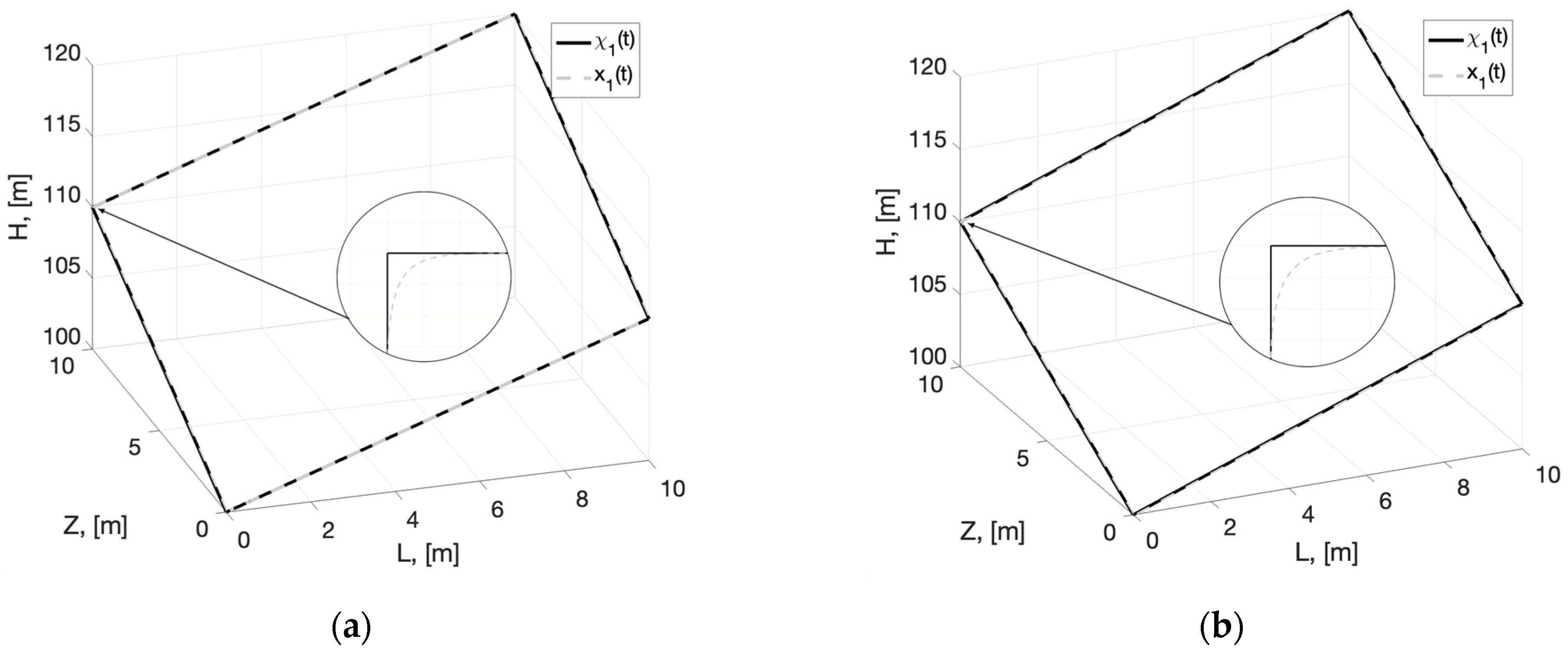
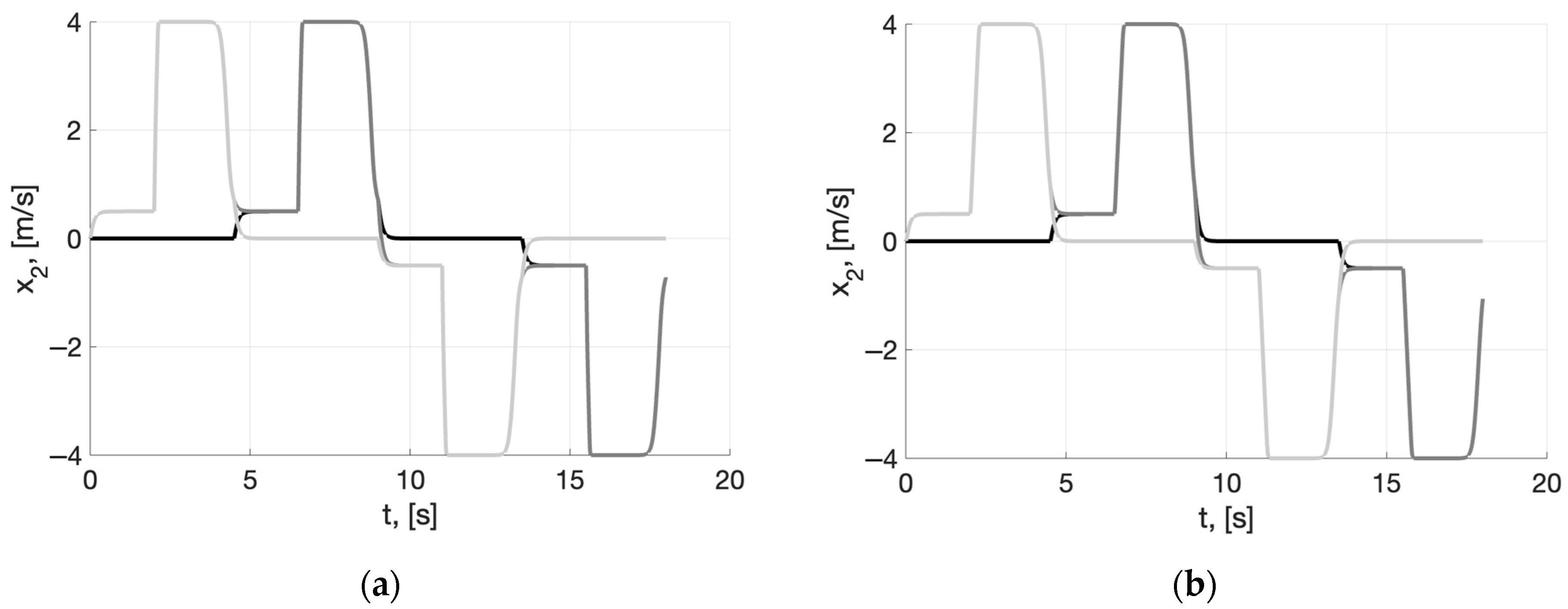
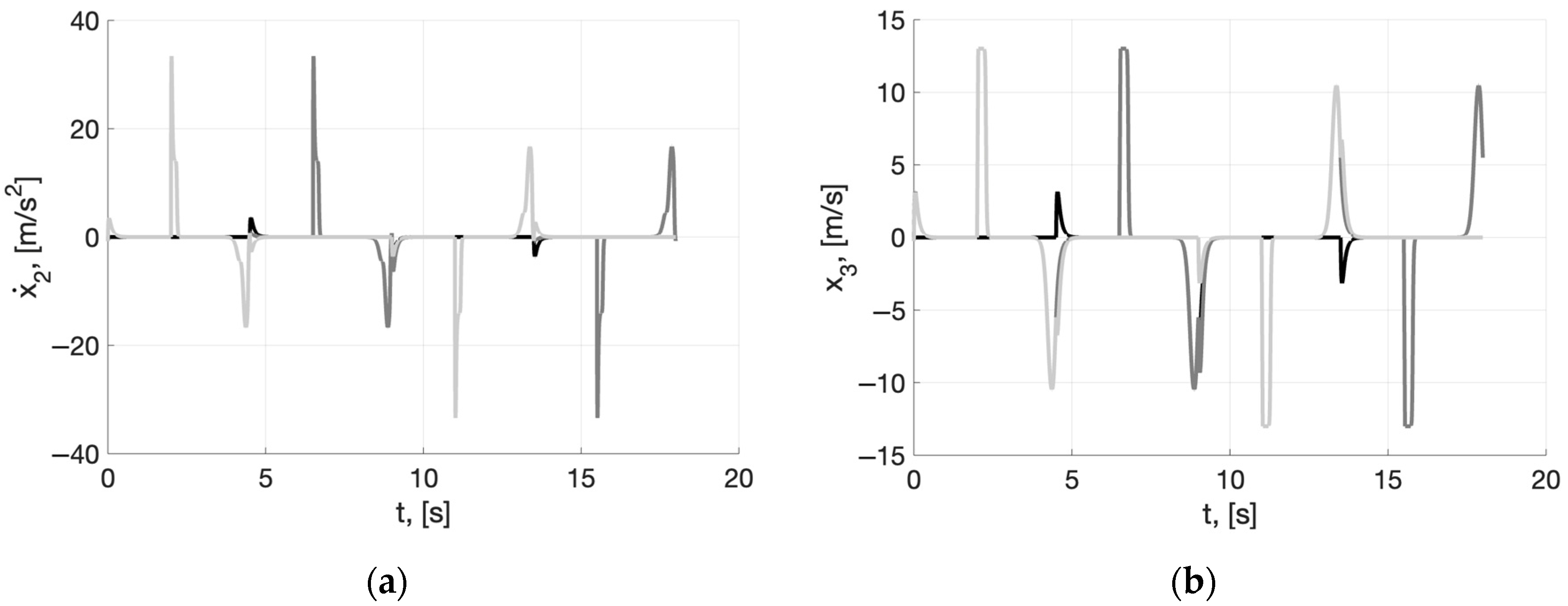
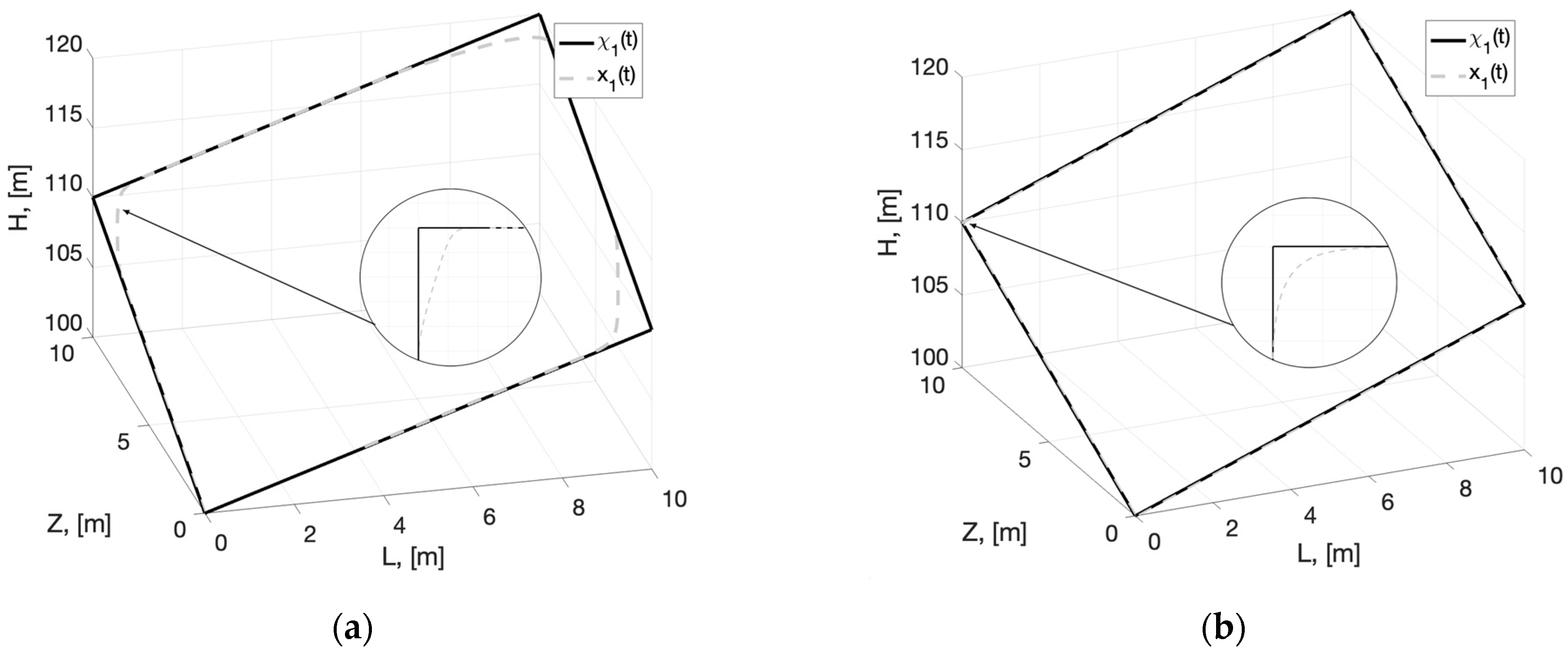
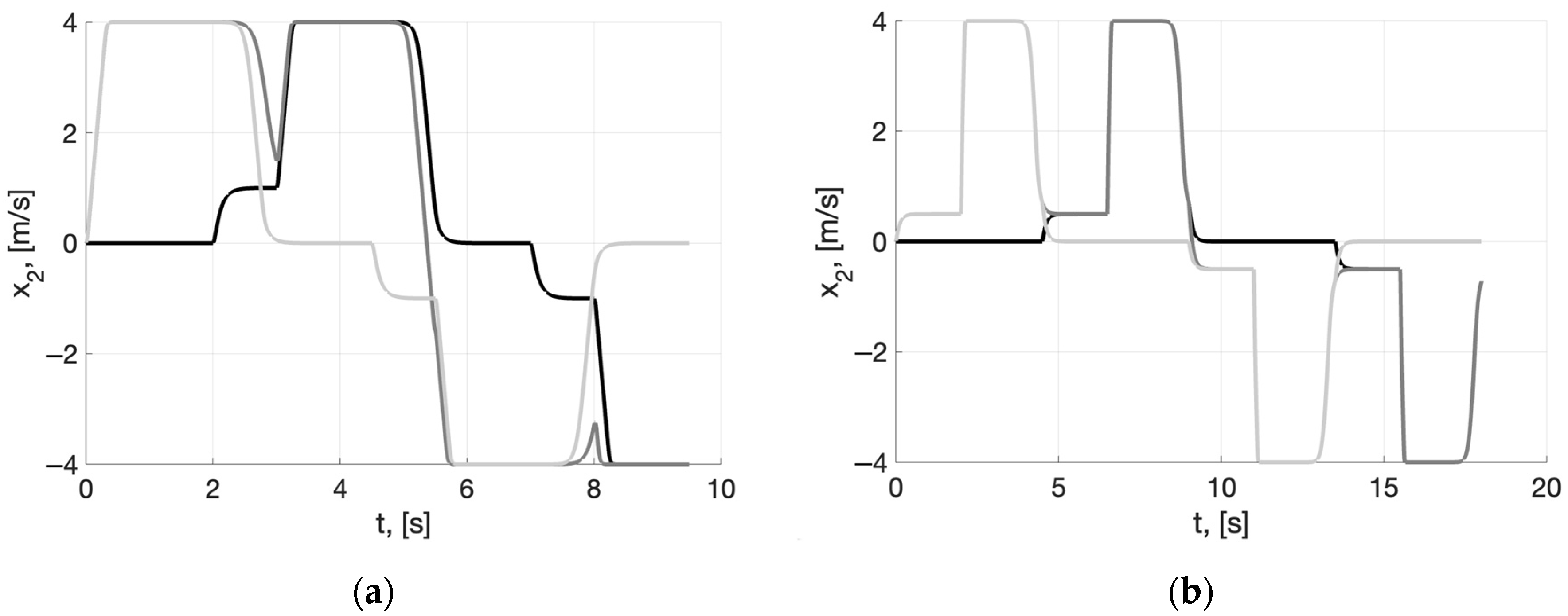
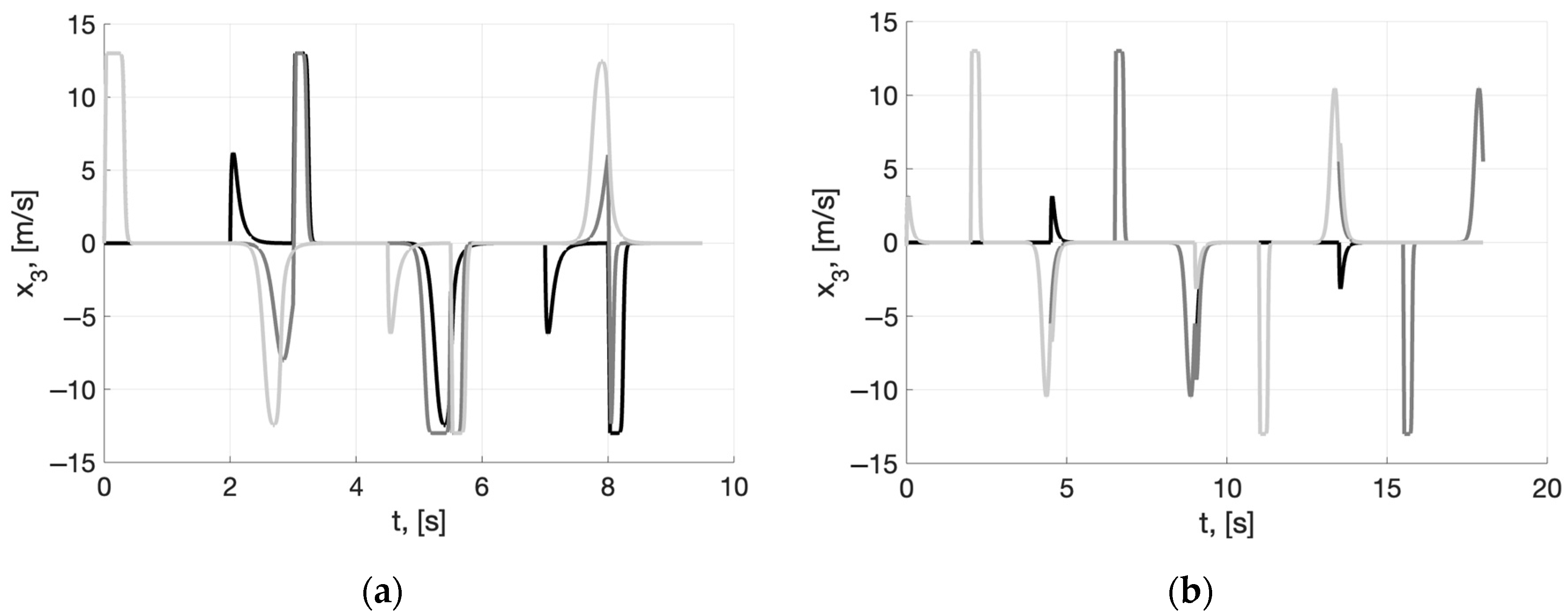


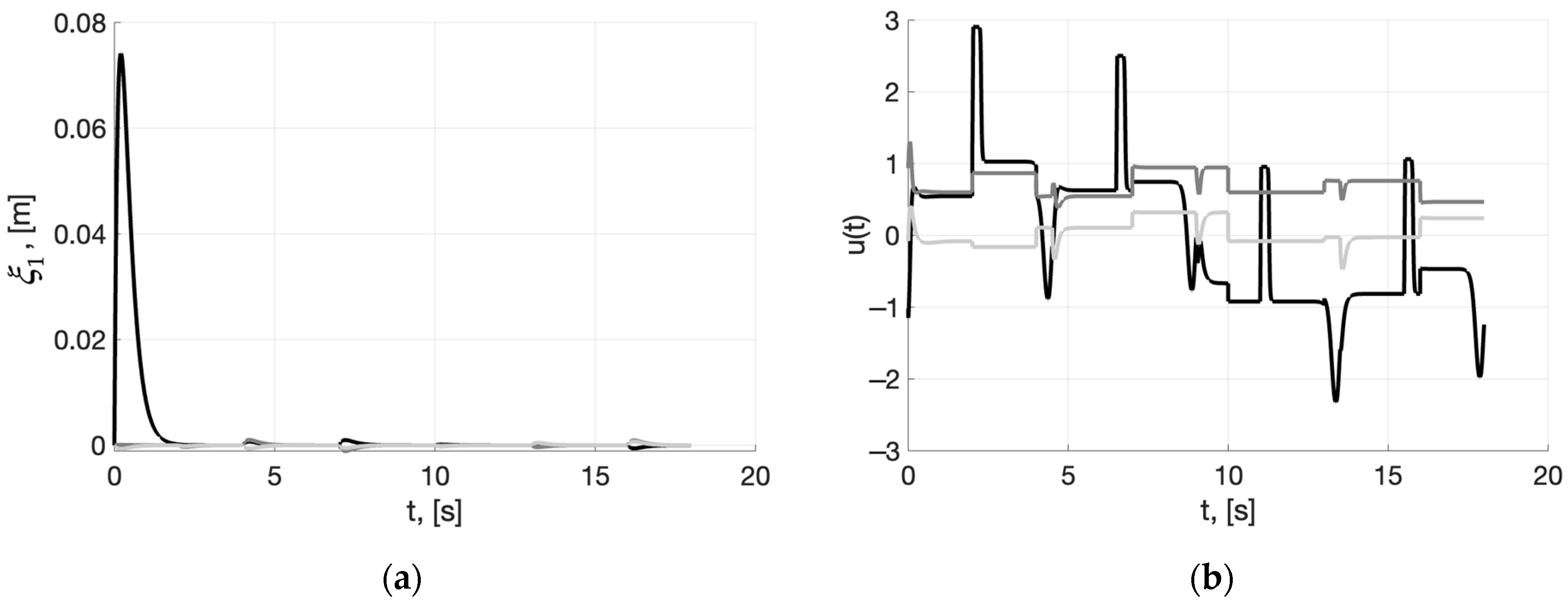
| Parameter | Value |
|---|---|
| Maximum weight, kg | 5 |
| Maximum altitude, m | 5000 |
| Maximum flight velocity, m/s | 26 |
| Flight duration, min | 60 |
| i | Li, m | Hi, m | Zi, m | ti, s, (Case 1) | ti, s (Case 2) |
|---|---|---|---|---|---|
| 1 | 0 | 100 | 0 | 0 | 0 |
| 2 | 0 | 101 | 1 | 2 | 1/9 |
| 3 | 0 | 109 | 9 | 2.5 | 1 |
| 4 | 0 | 110 | 10 | 4.5 | 2 |
| 5 | 1 | 111 | 10 | 6.5 | 3 |
| 6 | 9 | 119 | 10 | 7 | 3.5 |
| 7 | 10 | 120 | 10 | 9 | 4.5 |
| 8 | 10 | 119 | 9 | 11 | 5.5 |
| 9 | 10 | 111 | 1 | 11.5 | 6 |
| 10 | 10 | 110 | 0 | 13.5 | 7 |
| 11 | 9 | 109 | 0 | 15.5 | 8 |
| 12 | 1 | 101 | 0 | 16 | 8.5 |
| 13 | 0 | 100 | 0 | 18 | 9.5 |
Disclaimer/Publisher’s Note: The statements, opinions and data contained in all publications are solely those of the individual author(s) and contributor(s) and not of MDPI and/or the editor(s). MDPI and/or the editor(s) disclaim responsibility for any injury to people or property resulting from any ideas, methods, instructions or products referred to in the content. |
© 2023 by the authors. Licensee MDPI, Basel, Switzerland. This article is an open access article distributed under the terms and conditions of the Creative Commons Attribution (CC BY) license (https://creativecommons.org/licenses/by/4.0/).
Share and Cite
Krasnova, S.A.; Kokunko, J.G.; Utkin, V.A. Dynamic Models with Sigmoid Corrections to Generation of an Achievable 4D-Trajectory for a UAV and Estimating Wind Disturbances. Electronics 2023, 12, 2280. https://doi.org/10.3390/electronics12102280
Krasnova SA, Kokunko JG, Utkin VA. Dynamic Models with Sigmoid Corrections to Generation of an Achievable 4D-Trajectory for a UAV and Estimating Wind Disturbances. Electronics. 2023; 12(10):2280. https://doi.org/10.3390/electronics12102280
Chicago/Turabian StyleKrasnova, Svetlana A., Julia G. Kokunko, and Victor A. Utkin. 2023. "Dynamic Models with Sigmoid Corrections to Generation of an Achievable 4D-Trajectory for a UAV and Estimating Wind Disturbances" Electronics 12, no. 10: 2280. https://doi.org/10.3390/electronics12102280
APA StyleKrasnova, S. A., Kokunko, J. G., & Utkin, V. A. (2023). Dynamic Models with Sigmoid Corrections to Generation of an Achievable 4D-Trajectory for a UAV and Estimating Wind Disturbances. Electronics, 12(10), 2280. https://doi.org/10.3390/electronics12102280





